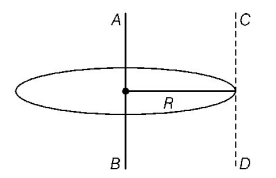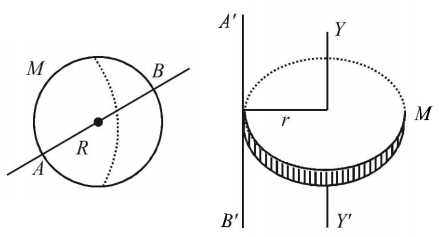111. The moment of inertia of a thin uniform rod of mass $$M$$ and length $$L$$ about an axis passing through its midpoint and perpendicular to its length is $${I_0}.$$ Its moment of inertia about an axis passing through one of its ends and perpendicular to its length is
A
$${I_0} + \frac{{M{L^2}}}{2}$$
B
$${I_0} + \frac{{M{L^2}}}{4}$$
C
$${I_0} + 2M{L^2}$$
D
$${I_0} + M{L^2}$$
Answer :
$${I_0} + \frac{{M{L^2}}}{4}$$
112.
A small mass $$m$$ is attached to a massless string whose other end is fixed at $$P$$ as shown in the figure. The mass is undergoing circular motion in the $$x-y$$ plane with centre at $$O$$ and constant angular speed $$\omega .$$ If the angular momentum of the system, calculated about $$O$$ and $$P$$ are denoted by $${\vec L_O}$$ and $${\vec L_P}$$ respectively, then

A
$${\vec L_O}$$ and $${\vec L_P}$$ do not vary with time
B
$${\vec L_O}$$ varies with time while $${\vec L_P}$$ remains constant
C
$${\vec L_O}$$ remains constant while $${\vec L_P}$$ varies with time
D
$${\vec L_O}$$ and $${\vec L_P}$$ both vary with time
Answer :
$${\vec L_O}$$ remains constant while $${\vec L_P}$$ varies with time
113. The moment of inertia of a uniform semicircular disc of mass $$M$$ and radius $$r$$ about a line perpendicular to the plane of the disc through the centre is-
A
$$\frac{2}{5}M{r^2}$$
B
$$\frac{1}{4}Mr$$
C
$$\frac{1}{2}M{r^2}$$
D
$$M{r^2}$$
Answer :
$$\frac{1}{2}M{r^2}$$
114. A particle moving in a circular path has an angular momentum of $$L.$$ If the frequency of rotation is halved, then its angular momentum becomes
A
$$\frac{L}{2}$$
B
$$L$$
C
$$\frac{L}{3}$$
D
$$\frac{L}{4}$$
Answer :
$$\frac{L}{2}$$
115. The moment of inertia of a uniform circular disc of radius $$R$$ and mass $$M$$ about an axis passing from the edge of the disc and normal to the disc is
A
$$\frac{1}{2}M{R^2}$$
B
$$M{R^2}$$
C
$$\frac{7}{2}M{R^2}$$
D
$$\frac{3}{2}M{R^2}$$
Answer :
$$\frac{3}{2}M{R^2}$$
116. Radius of gyration of a body depends upon
A
axis of rotation
B
translational motion
C
shape of the body
D
area of the body
Answer :
axis of rotation
117. At any instant, a rolling body may be considered to be in pure rotation about an axis through the point of contact. This axis is translating forward with speed
A
equal to centre of mass
B
zero
C
twice of centre of mass
D
None of the above
Answer :
equal to centre of mass
118. A solid sphere of mass $$M$$ and radius $$R$$ having moment of inertia $$I$$ about its diameter is recast into a solid disc of radius $$r$$ and thickness $$t .$$ The moment of inertia of the disc about an axis passing the edge and perpendicular to the plane remains $$I.$$ Then $$R$$ and $$r$$ are related as-
A
$$r = \sqrt {\frac{2}{{15}}} R$$
B
$$r = \frac{2}{{\sqrt {15} }}R$$
C
$$r = \frac{2}{{15}}R$$
D
$$r = \frac{{\sqrt 2 }}{{15}}R$$
Answer :
$$r = \frac{2}{{\sqrt {15} }}R$$
119. Initial angular velocity of a circular disc of mass $$M$$ is $${\omega _1}.$$ Then two small spheres of mass $$m$$ are attached gently to diametrically opposite points on the edge of the disc. What is the final angular velocity of the disc?
A
$$\left( {\frac{{M + m}}{M}} \right){\omega _1}$$
B
$$\left( {\frac{{M + m}}{m}} \right){\omega _1}$$
C
$$\left( {\frac{M}{{M + 4m}}} \right){\omega _1}$$
D
$$\left( {\frac{M}{{M + 2m}}} \right){\omega _1}$$
Answer :
$$\left( {\frac{M}{{M + 4m}}} \right){\omega _1}$$
120. Two particles which are initially at rest, move towards each other under the action of their internal attraction. If their speeds are $$v$$ and $$2v$$ at any instant, then the speed of centre of mass of the system will be
A
$$2v$$
B
$$0$$
C
$$1.5\,v$$
D
$$v$$
Answer :
$$0$$


